What is a Parallelogram?
A parallelogram is a quadrilateral, whose each pair of opposite sides is parallel. Suppose we have a parallelogram ABCD such that AB and DC are a pair of its opposite sides so that AB ‖ BC. Similarly, BC and AD are a pair of opposite sides such that BC ‖ AD.
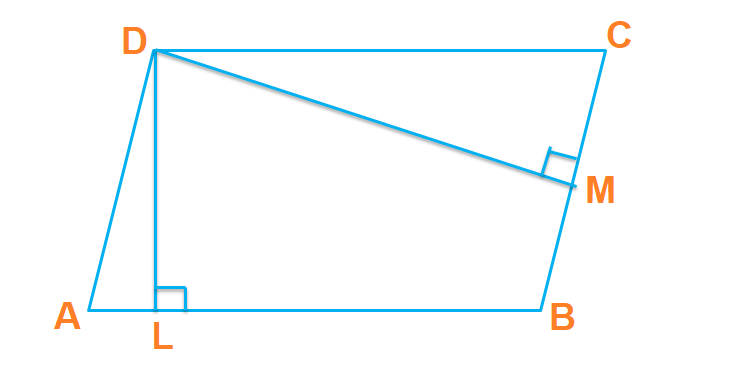
Properties of a Parallelogram
We now know that a parallelogram is a quadrilateral, whose each pair of opposite sides is parallel as well as equal. Below are some properties of a parallelogram that help us in different calculations including finding its area under different conditions:
- The opposite sides of a parallelogram are parallel and equal to each other.
- Since the parallelogram is a quadrilateral, the sum of all its angles is 360o
- The opposite angles of a parallelogram are equal. This means that for a parallelogram ABCD, the angle formed at vertex B would be equal to the angle formed at vertex D. Similarly, the angle formed at vertex A would be equal to the angle formed at vertex C.
- The adjacent angles of a parallelogram are supplementary, i.e. the sum of the adjacent angles of a parallelogram equals 180o. This means that for a parallelogram ABCD, the angle formed at vertex B + angle formed at vertex C = 180o. Similarly, the angle formed at vertex A + angle formed at vertex B = 180o.
- Diagonal of a parallelogram bisect each other.
- Rectangle, square and rhombus are special types of parallelograms.
Finding Area of a Parallelogram
Let us consider the above parallelogram, ABCD. If DL ⟂AB, then any line, then we find any line segment with its end-points on the two sides AB and DC perpendicular to them has the length DL. So, we call AB as the base and DL the corresponding altitude.
Similarly, if DM ⟂BC, then any line segment with its end-points on the two sides AB and DC perpendicular to them has the length DM. so we can call BC as the base and DM as the corresponding altitude.
We have,
Area of a parallelogram = Base x Altitude
Altitude is also known as height. So, we can say that,
Area of a parallelogram = Base x Height
For example, let us find the area of a parallelogram having the base = 5 cm and altitude = 4.2 cm.
We know that
Area of a parallelogram = Base x Altitude
Here, base = 5 cm and altitude = 4.2 cm
Therefore,
Area = (5 x 4.2) cm2 = 21 cm2
Solved Examples
Example 1
A mirror is made of two congruent parallelograms as shown in the diagram. The parallelograms have a combined area of 9 1/3 square metres. The height of each parallelogram is 1 1/3 metres. What is the length of the base of each parallelogram?
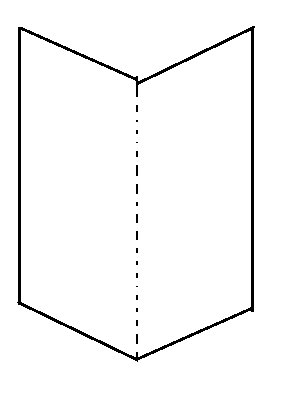
Solution: We have been given that the mirror is made of two congruent parallelograms. Since the given parallelograms are congruent, therefore, the area of two parallelograms will be equal.
Hence, we can say that,
The total area of the two parallelograms = $9\frac{1}{3}$ m2
The total area of the two parallelograms = $\frac{28}{3}$ m2
Therefore,
Area of one parallelogram = $\frac{28}{3}$ m2 ÷ 2
Area of one parallelogram = $\frac{14}{3}$ m2
Now, we know that,
Area of a parallelogram = Base x Height
Also, we have been given that the height of each parallelogram is $1\frac{1}{3}$ m
Height = $1\frac{1}{3}$ m = $\frac{4}{3}$ m
Hence, by putting the values of the area of one parallelogram and height in the above formula, we get,
$\frac{14}{3}$ = Base x $\frac{4}{3}$
⇒ Base = $\frac{14}{3}\times \frac{3}{4}$ m
⇒ Base = $\frac{7}{2}$ m = $3\frac{1}{2}$ m
Hence, base of the each parallelogram = $3\frac{1}{2}$ m
Example 2
The base of a parallelogram is thrice its height. If the area of the parallelogram is 867 m2, find the base and the height of the parallelogram.
Solution: We have been given that the area of the parallelogram is 867 m2.
Also,
The base of a parallelogram is thrice its height. Let the height of the parallelogram be h cm. Then,
The base of the parallelogram will be 3h
Now, we know that
Area of a parallelogram = Base x Height
Putting the given values in the above formula we get,
867 = 3h x h
⇒ 3h2 = 867
⇒ h2 = 289
⇒ h = $\sqrt{289}$
⇒ h = 17 cm
Now, that we know the height of the parallelogram, we can find the base as well
Base of the parallelogram = 3h = 3 x 17 = 51 cm.
Hence, base of the parallelogram = 51 cm, height of the parallelogram = 17 cm.
Example 3
A field in the form of a parallelogram has a base 15 dam and altitude 8 dam. Find the cost of watering the field at the rate of 50p per square metre.
Solution: We have been given that,
The base of the field = 15 dam
The altitude of the field = 8 dam
We need to find the cost of watering the field at the rate of 50p per square metre. Note: the above units are in dam, while we need to calculate the cost of watering the field in m2. Therefore, we must first convert these units to metres.
We know that
1 dam = 10m
Therefore,
Base of the field = 15 dam = 150 m
Altitude of the field = 8 dam = 80 m
Now, to find the cost of watering the field at the rate of 50p per square metre, we need to find the area of the parallelogram.
We know that
Area of a parallelogram = Base x Height
Putting the given values in the above formula we get,
Area of the field = (150 x 80) m2 = 12000 m2
Rate of watering the field = 50p per square metre = £0.5 per square metre
Therefore,
Cost of watering the field at the rate of 50p per square metre = £(12000 x 0.5)
=£6000
Hence, the cost of watering the field at the rate of 50p per m2 = £6000
Example 4
In a parallelogram, ABCD, CM ⟂ AB and BL ⟂ AD
a) If AB = 16 cm, AD = 12 cm and CM = 10 cm, find BL
b) If AD = 10 cm, CM = 8 cm and BL = 12 cm, find AB
Solution:
a) First, we should draw the given parallelogram and understand what is given to us.
Therefore, we have the following parallelogram
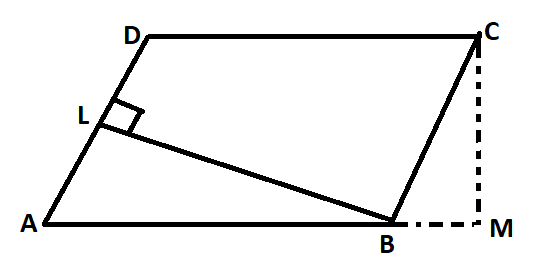
Now, we have been given that AB = 16 cm, AD = 12 cm and CM = 10 cm. We need to find BL.
In the given parallelogram, we can clearly see that AB is one of the bases and CM is the corresponding altitude.
We know that
Area of a parallelogram = Base x Height
Putting the given values in the above formula we get,
Area of the parallelogram ABCD = (16 x 10) cm2 = 160 cm2
Since we have BL as the altitude to the side AD, therefore, AD can also be used as a base of the parallelogram. This means that another way to calculating the area of this parallelogram is to use AD as the base and BL as the corresponding height.
Thus,
Area of the parallelogram ABCD = AD x BL
⇒ Area of the parallelogram ABCD = 12 x BL
Now, the two areas thus obtained are of the same parallelogram and therefore should be equal. We now have,
12 x BL = 160
⇒ BL = 160/12 = 13.33 cm
Hence BL = 13.33 cm
b) We have been given that AD = 10 cm, CM = 8 cm and BL = 12 cm. We need to find AB.
Again, the diagrammatic representation of this parallelogram shall be the same as in the above part.
Therefore, in the given parallelogram, we can clearly see that AD is one of the bases and BL is the corresponding altitude.
We know that
Area of a parallelogram = Base x Height
Putting the given values in the above formula we get,
Area of the parallelogram ABCD = (10 x 12) cm2 = 120 cm2
Since we have CM as the altitude to the side AB, therefore, AB can also be used as a base of the parallelogram. This means that another way to calculating the area of this parallelogram is to use AB as the base and CM as the corresponding height.
Thus,
Area of the parallelogram ABCD = AB x CM
⇒ Area of the parallelogram ABCD = AB x 8
Now, the two areas thus obtained are of the same parallelogram and therefore should be equal. We now have,
AB x 8 = 120
⇒ AB = 120/8 = 15 cm
Hence AB = 15 cm



Example 5
The longer side of a parallelogram is 54 cm and the corresponding altitude is 16 cm. If the altitude corresponding to the shorter side is 24 cm, find the length of the shorter side.
Solution: Let ABCD be a parallelogram with the longer side AB = 54 cm and corresponding altitude AE = 16 cm.
Diagrammatically, the given parallelogram can be represented as:
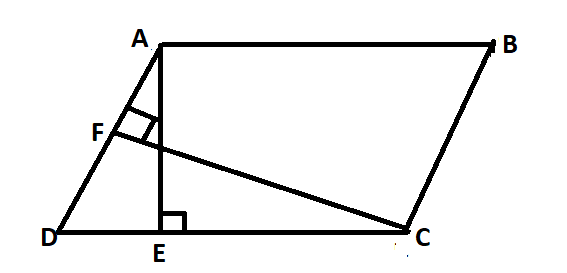
The above diagram shows that the shorter side is BC and the corresponding altitude is CF. Now we are given that the altitude corresponding to the shorter side is 24 cm. therefore,
CF = 24 cm
Also, we are given the longer side of a parallelogram. Therefore,
AB = CD = 54 cm
Also, and the corresponding altitude to the longer side is 16 cm. therefore,
AE = 16 cm
We know that
Area of a parallelogram = Base x Height
We have two sets of bases and the corresponding altitudes. Therefore, we can say that –
Area of a parallelogram = BC x CF……………………….. (1)
and
Area of a parallelogram = AB x AE………………………………(2)
Since both (1) and (2) represent the area of the same parallelogram they should be equal. Hence, equating the equations (1) and (2), we have
BC x CF = AB x AE
Now, we already have, AB = 54 cm, CF = 24 cm and AE = 16 cm. putting these values in the above equation, we have
BC x 24 = 54 x 16
⇒ BC = $\frac{54\times16}{24}$ = 36 cm
Hence, the shorter side of the parallelogram, i.e. BC = 36 cm
Example 6
A floral design on the floor of a building consists of 280 tiles. Each tile is in the shape of a parallelogram of altitude 3 cm and base 5 cm. Find the cost of polishing the design at the rate of 50 p per cm2.
Solution : We have been given that the floral design on the floor of a building consists of 280 tiles. Also, each tile is in the shape of a parallelogram of altitude 3 cm and base 5 cm.
We need to find the cost of polishing the design at the rate of 50 p per cm2.
In order to do so, we must first calculate the area covered by the tiles.
Therefore, first, we must calculate the area covered by one tile.
Since, the tile is in the shape of a parallelogram,
Area of one tile = Base x Height
Base of the tile = 5 cm
Height of the tile = 3 cm
Hence, Area of one tile = (5 x 3) cm2 = 15 cm2
Now. Total number of tiles = 280
Area covered by 280 tiles = (280 x 15) cm2 = 4200 cm2
Cost of polishing the design = 50 p per cm2 = £0.5 per cm2
Cost of polishing 4200 cm2 = £ (0.5 x 4200) = £2100
Hence cost of polishing the design at the rate of 50 p per cm2 = £2100
Example 7
Find the altitude of a parallelogram in metres whose area = 2.25 m2 and base is 25 dm.
Solution: We have been given that the area of the parallelogram= 2.25 m2
Also, base of the parallelogram = 25dm
Note the change in dimensions. Before proceeding further, we must first ensure that all the given values are in the same dimensions.
We know that 1 m = 10 dm
Therefore
1 dm = 1/10 m
25 dm = 25/10 m = 2.5 m
Now, we know that
Area of a parallelogram = Base x Height
Putting the given values in the above formula we get,
2.25 = 2.5 x Height
Height = 2.25/2.5 m = 0.9 m
Hence, the height of the parallelogram = 0.9 m
Example 8
The adjacent sides of a parallelogram are 10 m and 8 m. If the distance between the longer sides is 4 m, find the distance between the shorter sides.
Solution: Let ABCD be a parallelogram with the longer side AB and shorter side BC.
Diagrammatically, the given parallelogram can be represented as:
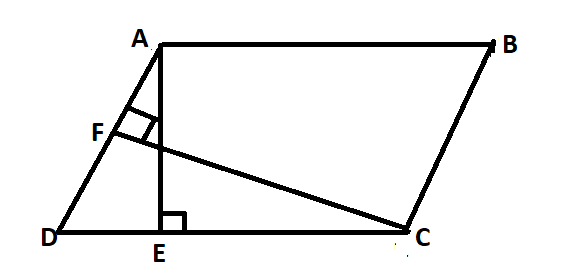
The above diagram shows that the distance between the longer sides, AB and DC is AE which is given to as 4 m. Now we are given that the altitude corresponding to the longer side is 4 cm. therefore,
AE = 4 cm
Also, we are given the longer side of a parallelogram. Therefore,
AB = CD = 10 cm
Also, and the shorter side of the parallelogram BC is also given to us. Therefore,
BC = 8 cm
We know that
Area of a parallelogram = Base x Height
We have two sets of bases and the corresponding altitudes. Therefore, we can say that –
Area of a parallelogram = BC x CF……………………….. (1)
and
Area of a parallelogram = AB x AE………………………………(2)
Since both (1) and (2) represent the area of the same parallelogram they should be equal. Hence, equating the equations (1) and (2), we have
BC x CF = AB x AE
Now, we already have, AB = 10 cm, BC = 8 cm and AE = 4 cm. putting these values in the above equation, we have
8 x CF = 10 x 4
⇒ CF = $\frac{10\times4}{8}$ = 5 cm
Hence, the distance between the shorter sides of the parallelogram, i.e. CF = 5 cm
Example 9
The area of a parallelogram is 338 m2. If its altitude is twice the corresponding base, determine the base and the altitude.
Solution: We have been given that the area of the parallelogram is 338 m2.
Also, the altitude is twice the corresponding base.
Let the base of the parallelogram be b cm. Then according to the condition given in the question,
The altitude of the parallelogram = 2b
We know that
Area of a parallelogram = Base x Height
Putting the given values in the above formula we get,
338 = b x 2b
2b2 = 338
b2 = 338/2 = 169
b = $\sqrt{169}$ = 13 cm
Hence, base of the parallelogram = 13 cm.
Now, that we know the base of the parallelogram, we can find the height as well
Height of the parallelogram = 2b = 2 x 13 = 26 cm
Hence, base of the parallelogram = 13 cm, height of the parallelogram = 26 cm.
Recommended Worksheets
Area of Other Quadrilaterals (Province Themed) Math Worksheets
Quadrilaterals (Real Estate Themed) Math Worksheets
Word Problems Involving Perimeter and Area of Polygons (Carpentry Themed) Worksheets









